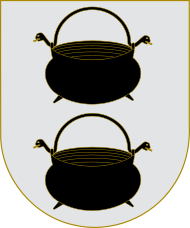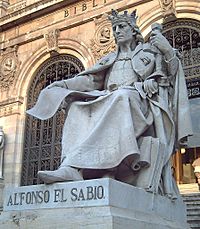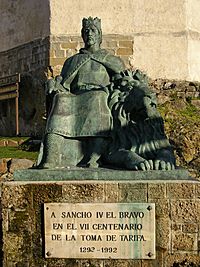Álvaro Núñez de Lara (died 1287) facts for kids

Álvaro Núñez de Lara (born around 1261 – died 1287) was a Castilian nobleman. He was the son of Juan Núñez I de Lara, who was the leader of the important House of Lara family. His mother was Teresa Álvarez de Azagra.
Contents
Family Background
Álvaro Núñez de Lara's father was Juan Núñez I de Lara, the head of the powerful House of Lara. His mother was Teresa Álvarez de Azagra, who was the Lady of Albarracín.
His grandparents on his father's side were Nuño González de Lara, also known as "the Good," and Teresa Alfonso. On his mother's side, his grandparents were Álvaro Pérez de Azagra, Lord of Albarracín, and Inés. Inés was the daughter of King Theobald I of Navarre.
Álvaro also had several half-brothers and half-sisters. They were born from his father's second marriage. These included Juan Núñez II de Lara, who later became the head of the House of Lara, and Nuño González de Lara. His half-sisters were Teresa Núñez de Lara y Haro and Juana Núñez de Lara.
Life and Actions
Álvaro Núñez de Lara was likely born around the year 1261. Some historians once thought he was the son of his father's brother. However, later research using old records has shown that he was indeed the son of Juan Núñez I de Lara.
Supporting Prince Sancho

In 1282, Álvaro Núñez de Lara chose to support Infante Sancho. Sancho was the son of King Alfonso X of Castile. At this time, Sancho was rebelling against his father. King Alfonso X wanted his grandson, Alfonso de la Cerda, to be the next king instead of Sancho.
Álvaro joined Prince Sancho when he left Córdoba. Their goal was to stop a rebellion in the city of Badajoz. Badajoz had previously supported Prince Sancho but had changed sides. After this, Álvaro went with Sancho to defend Córdoba. King Alfonso X and Sultan Abu Yusuf Yaqub of Morocco were attacking Córdoba. Both kings eventually had to stop their attack. King Alfonso then moved on to Seville.
Changing Sides
In 1283, Álvaro Núñez de Lara decided to leave Prince Sancho's side. He then joined King Alfonso X, Sancho's father. Other noblemen also joined him, including Nuño Fernández de Valdenebro and Juan Fernández "Cabellos de Oro". To avoid being caught, they traveled through Portugal. They continued their journey until they reached Seville, where King Alfonso was staying.
After arriving in Seville, King Alfonso gave Álvaro a new mission. He was to join an expedition led by infante John of Castile and Fernán Pérez Ponce de León I. Their goal was to capture Mérida, which was controlled by Prince Sancho's supporters. Álvaro was joined by other nobles on this mission. The expedition was successful, and King Alfonso's forces quickly took Mérida.
After King Alfonso's Death
In April 1284, King Alfonso X died in Seville. His son, Prince Sancho, became the new king, known as Sancho IV. After Alfonso's death, Álvaro Núñez de Lara played an important role. He helped a group of nobles prevent infante John, the new king's brother, from taking control of Seville.
Later, Álvaro was present when King Sancho IV entered Córdoba and Seville. He also witnessed King Sancho confirm the special rights of the city of Seville.
The Siege of Jerez

In 1285, Sultan Abu Yusuf Yaqub attacked Jerez de la Frontera. Álvaro Núñez de Lara went with King Sancho to help lift the attack. They were successful. Afterward, Álvaro was part of a group of nobles who advised King Sancho to fight against the Muslims. However, infante John and Lope Díaz III de Haro, a powerful lord, disagreed. They threatened to leave the king if he insisted on fighting. They believed the king should be happy with having simply ended the attack on Jerez.
In 1285, Álvaro Núñez de Lara also confirmed several special rights given by King Sancho. On December 6, Prince Ferdinand was born. He was the son of King Sancho and Queen María de Molina and would be the next king. The following year, Álvaro joined the King on a trip to Santiago de Compostela.
Conflict and Return
In 1286, Álvaro Núñez de Lara left Castile. This was because he did not get along with Lope Díaz III de Haro, who was the king's favorite. Álvaro went to Portugal. There, he used his friendship with infante Alfonso of Portugal to attack Castilian lands. Prince Alfonso was having problems with his brother, King Denis.
King Denis, who had good relations with King Sancho, ordered his border towns to attack Prince Alfonso and Álvaro. Álvaro and Prince Alfonso lost many men in these fights. Soon after, the castle of Arronches, which Prince Alfonso held, was attacked by the armies of Portugal and Castile. However, on December 13, 1286, King Denis signed a peace treaty with his brother Alfonso. As part of the agreement, Prince Alfonso had to give the castle of Arronches to the king.
Because Lope Díaz III de Haro was becoming very powerful in Castile, Álvaro Núñez de Lara was convinced to return. He wanted to use his own power to stop the unfair actions of Lope Díaz III de Haro.
Álvaro Núñez de Lara died in early 1287, not long after he returned to Castile. He never married and did not have any children.
See also
 In Spanish: Álvaro Núñez de Lara (m. 1287) para niños
In Spanish: Álvaro Núñez de Lara (m. 1287) para niños

